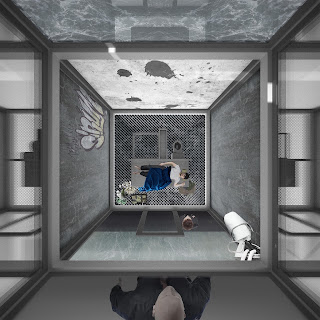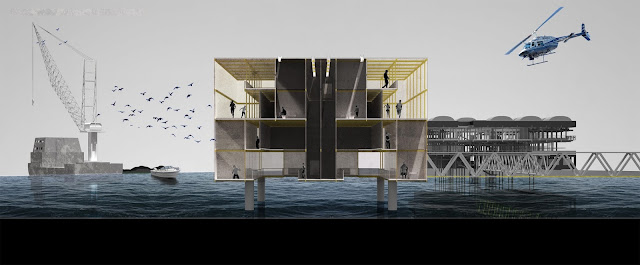Off of the coast of Suratthani, there are 5 commissioned plots in the Gulf of Thailand with 16 central processing units surrounded by more than 300 wellheads in total, currently able to produce more than 120,000 barrels of crude oil daily which accounts for more than 50% of the total production in Thailand. These platforms are usually composed of a processing platform and at least one living quarter for its workforce.
Locating almost 200 kilometers off of the shore is the Platong oil platform, over hundreds of drill heads surrounding it. Over the years since its first construction in 1984 with two building structures, the processing unit has been under constant expansion with its latest construction in 2011, now totalling with 5 platforms.
It is a very controversial piece of architecture. Its installation with the jacket legs placed on the seabed destroys the habitats of many animals. During its operation, seismic waves used for search of oil disturbs fish and sea mammal activities. Question of ecological effects arise most during its deconstruction. Topping, one of the most utilised option, is the removal of the upper deck structure, and explosion of the upper 20 meters of the jacket structure. Toppling is a similar process, but the jacket structure is laid down on its side and left on the seabed. These are amongst several other options, all of which to disassemble these platforms, not only does the costs exceed the price of construction, but it creates a significant impact on the surrounding ecosystem.
On the other hand, there are also many issues pertaining to the current state of the thai prison system and facilities. In thailand, there are more than 150 correctional facilities, that are occupied by almost 300,000 prisoners, mainly convicted from cases of drug usage and smuggling.
Typical prison programs are composed of cells of various types (group, single, supermax, isolation cells), dayrooms, security quarters, administrative offices, visiting rooms, and kitchen/washing areas. The assigning of cell types depend on the level of risk assessment, divided into 6 levels from most harm confined in supermax cells which are the highest security units as level 6, levels 5, 4, and 3 are of medium risk, confined in single cells and sometimes group cells, and levels 2 and 1 are of no risk, and are of a benefit to the facilities (teaching or administrative responsibilities). Generally, levels 1 to 4 prisoners in Thailand are assigned a specific task/chore that they are responsible for.
A general daily schedule of a responsible prisoner would be to wake up at 6 am, getting ready for work at 8:30 until 3:00 with an hour lunch break, before getting ready for bed at 4 and praying and lights out at 9PM. A newly convicted with no assigned chores would instead spend their days religiously by listening to buddhist preachings, before also finally assigned a chore.
The current state of the Thai prison is insufficient spaces for each individual and poor environmental conditions. An international prison standard requires that each prisoner is provided a 7 square meter sleeping space. The thai standard provides 2.25 square meters of sleeping space, but in the real current situation, there is only 85 square centimeters of sleeping space per inmate.
This issue is mainly caused by high recidivism rates (or rates of being re-convicted) of more than 50%. The problem is not that there are inadequate facilities, but the rehabilitation program for these prisons. The existing prison system emphasizes on denying any freedom and focuses on confinement at the most terrible environments, but not in reforming the minds to become psychologically fit once returning to society. Upon release, these prisoners are not, in anyway, reformed or corrected, and returns to their previous ways, thus, being convicted again.
In these abandoned oil platforms, a re-imagined prison system utilising elements of natural environment as a method of prisoners’ rehabilitation introduces life into a once rigid and environmentally harmful structure. It is a proposal of the environmental manipulation, testing of its effects on human behavior. Different security leveled cells are assigned to a different platform and spaces created reuses the existing superstructure of the rigs, collaborating architecture with the earthly elements. Light, water, plant and animal species, and wildlife defines the activities allowed in each platform. Prisoners would go through the process of rehabilitation through spaces manipulated for each element, as nature restores peace to the mind, learning to live and provide for one another in this micro-colonization, to be able to reintegrate into society when released.
Design Narrative
Upon arrival on boat, it is one of the two times in which one would see the whole facility in its complete glory, the other time being their release. In the sunset background, there are a total of five platforms all of with are connected by long walkway truss structures between each building, raised high from the water level. Departing from the boat, prisoners are processed through security and administration, before each individual being escorted to their cells. There are two walkways, one on either side. The walkway on the right leads to the rehabilitation center, which houses programs for those suspected for mental issues. The walkway on the opposite side leads to the Observ-a-ray, or the the highest security cells facilities.
In platform Observ-a-ray in the night time, the cells are dark, except for the moonlight from the night sky through the upper half of the wall fully open for views up the sky. Automatically awaking to the rays of morning sun through the exterior facade, the canvas clad of the lower half of the wall allows for light penetration, but no views out into the water.
Shadows are casted onto the interior, a similar fabric clad wall, which is a means of keeping security in these supermax cells. These cells could be observed from the inside, as well as from under the platform. Views outside are prohibited both in the cells and the dayroom area above that they are allowed to use from 8 to 9 PM everyday. These cladding allows for a level of privacy, but creates a feeling of constant scrutiny through light movement.
These inmates are observed by doctors, guards, and psychologists from the upper observation terrace level for their behavior assessment, and the upgrading of ranks to move another platform.
On the same platform, in the upper level are the isolation cells. Current inmates who are being punished are isolated in these cells, for various lengths of time up to 12 weeks. A long walkway up to the upper floors is led by a light strip before entering into complete darkness of a walkway to each cells.
All four walls of the cells are solid, with the only light source from an opening in the ceiling to allow in sunlight through the day. These prisoners are stripped of any connections, views, or human contact as a form of punishment. They are forced to reflect in this situation. With light playing a crucial role in the atmospheric spaces of cells in this platform, it becomes a symbol of freedom.
The cells are accessed through a lower walkway under the platform, overlooking the two fenced pools of seawater, leading up to the atrium surrounded by prisoners and unifying them. Walking up 3 flights of stairs to reach the rooms, there are 4 quarters of different cell shafts, decentralized into smaller groups.
There are no views to the outside, still, but only up and down, to the sky and down to the water. There are a couple of other inmates enjoying the water under the overhead sun, and sounds of waves crashing resonate throughout the space. Above the cells on the topmost level are security walkways where guards patrol for control of prisoners. In the central strip of tower above the entry walkway are administration programs, a kitchen, and security offices.
In these hydro cells, the time spent in the ‘dayrooms’ or these pools are increased to be up to 6 hours a day, with 18 hours spent in the cell. They are encouraged to get to know better their fellow inmates, and increase human interaction in preparation to the next level. No chores are yet assigned to the prisoners. But they undergo a process of therapy through crashing of waves as white noise that is unavoidable.
Into the final level, the utmost level of relative freedom in the facilities are the Staple-r-s, the production house of the prison. On the walkway to the platform, the busy activities of the prisoners are seen, both in the building as well as on water. Not only do they keep the prison running, but they provide for all these prisoners life staples, from cultivating vegetables and fish species, to provide food and cooking for all their fellow inmates, but some are assigned administrative chores as part of their daily routine--planting, pruning, watering, harvesting, cooking in a cycle.
Some vegetables cultivated are beets, potatoes, spinach, broccoli amongst many others, all of which could withstand salinity. They are highly exposed to the environment, some as farmers, some as fishermen.
The space, is again decentralized through smaller atriums which vertically connects the sea to the sky in various points in the platform. Plantation plots are scattered around the spaces, with spaces of sleeping rooms, dayrooms, and the infirmary, for example, which creates a closer connection between flora and fauna and prisoners, and to the sky and water. On the rooftop are desalination mechanical units, which provides freshwater through for the whole facility. Security control is at minimum in this platform, and prisoners are allowed to roam around freely in their daily routine.
There are no longer cells, but group sleeping rooms, dividable by sheer curtain for a small level of privacy. Communication and interaction between individuals are key in the survival on this platform.
The routine and chores implemented are not only for the benefit of the prison, but for the convicts themselves, as a training opportunities so they are capable of making a living once they are released.
Experiencing each platform with different environmental elements, they slowly develop through the process of rehabilitation with subtle changes in freedom and comfortability. Communication and interaction is encouraged at different levels, and in this final phase in rehabilitation, these prisoners are ready for the real world with job experiences along with a responsible and reformed mind state as the ELE-Mental Facilities.
Staff Quarters
Proposed Structural Treatment



















































